Tags
High Speed 1, London, Memory Lane, Railways, St Pancras, Travel
I consider myself fortunate to have an extensive photo archive because, whilst the memory may fade as I get older, the photographs don’t. They’ll always be there to transport me back in time and allow me to relive my past – and to reflect on how much things have changed. Here’s one example…
I’ve known London’s St Pancras station ever since the early 1970’s and I’ve been a regular visitor since. It’s hard to credit now but at one time this magnificent building with its fantastic Gothic frontage was threatened with demolition. Luckily, sanity prevailed and it was saved. I remember it in its BR days when it was run-down and shabby, All the long-distance services had been withdrawn so it was often quiet with little activity compared to other London termini. As all trains were diesel operated it could be a noisy, dirty place and glorious arched roof, whilst offering maximum protection from the elements offered little in the way of natural light. Here’s a shot taken in 1991 when the local services to Bedford had already been electrified and diverted via the Thameslink tunnels.
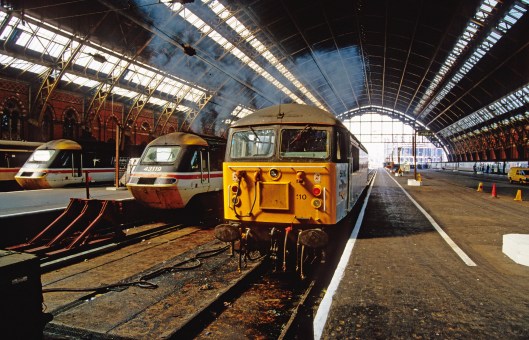
On the far left you can see a parcels van stabled in one of the centre roads. This would have been part of a travelling Post Office set that sat here during the day before being used overnight. The HST sets had taken over from the earlier ‘Peak’ Class diesel locos to run the remaining long distance services to Nottingham, Derby and Sheffield. The Class 56 was sat here as St Pancras was a traincrew depot and BR drivers were still passed out to work both passenger and freight trains. The old taxi rank to the left was deserted in those days. The only time it sprang to life was in the evenings when it would be full of Royal Mail vans delivering sacks of letters to the various mail trains which left the station each night, adding welcome life to what was a sadly underused station. Here’s an October 1993 shot of the Travelling Post Office train which was always stabled in ‘siding A’ during the day before coming to life in the evening. I can’t remember where this used to run to now, maybe others do?

Now we move on a few years – to April 2002…
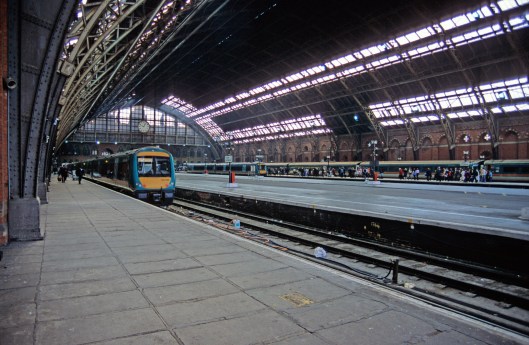
Here’s a post-privatisation scene when services were run by Midland Mainline who took over BR services in 1996. Class 170 Turbostars had been introduced in 1999 to run the stopping services to Leicester freeing up HSTs for other work. They didn’t last long as they were transferred to Central Trains in 2004 after being displaced themselves by the arrival of the Class 222 ‘Meridian’ fleet. The station was looking sadly neglected at this point, but appearances can be deceptive, as you’d have noticed if you’d turned around from this view. The station was being prepared for its new role as an international terminus…

This view taken a few months later in October 2002 shows the new Eastern train shed being built outside the Barlow roof . The whole area was one massive building site that was constantly changing. I was very lucky to get to visit the Hs1 construction sites on a regular basis as I was documenting the project for RAIL magazine. If you want to see more of the photos of HS1 being built, visit this gallery on my Zenfolio website.
At the same time the new platforms and trainshed were under construction work was going on at the front of the station to extend the London Underground ticket offices and concourse on Kings Cross St Pancras tube station. This entailed demolishing the ramp at the front of the station, building the new entrances to the tube station, then rebuilding the ramp.

On 8th April 2004, shortly before the Barlow train shed was closed for conversion to the new Eurostar terminus, there was a last ‘Peak’ at St Pancras when 45112worked a special train to Derby and back.
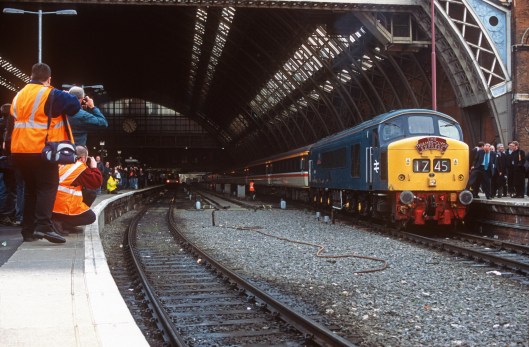
For a while the Thameslink line was severed in order to allow construction of the ‘Thameslink box’ (which would later house the new Thameslink station. This meant that Thameslink trains from the North terminated in the new East side platforms which would later be used by the high-speed ‘Javelin’ service into Kent. Here’s the first of the class, 319001 in Connex livery and 319450 in Thameslink livery on the 29th October 2004.
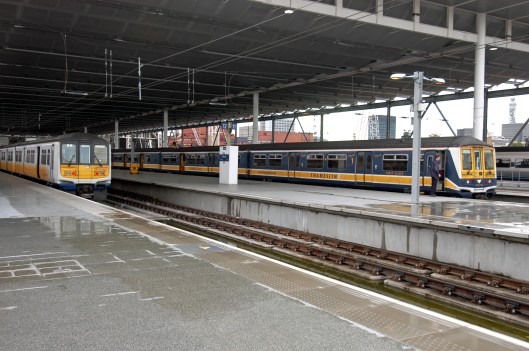
Finally after years of being a building site St Pancras was reopened as an international station by Queen Elizabeth 2nd on the 6th November 2007. It remains one of my favorite stations. The transformation was a superb job by all concerned. The station went from a dingy, decaying, underused space to a destination in it’s own right. Compare some of the early photos to these…
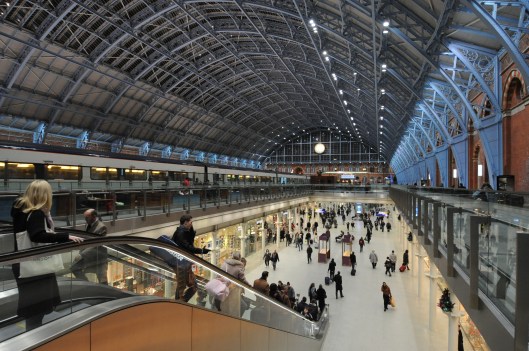
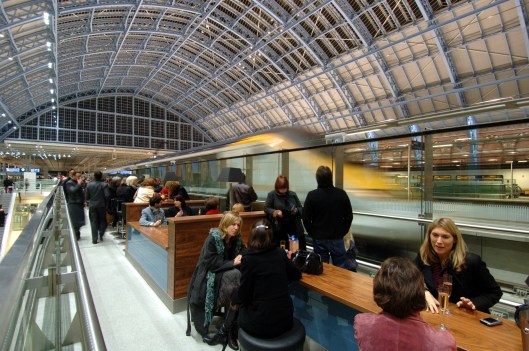


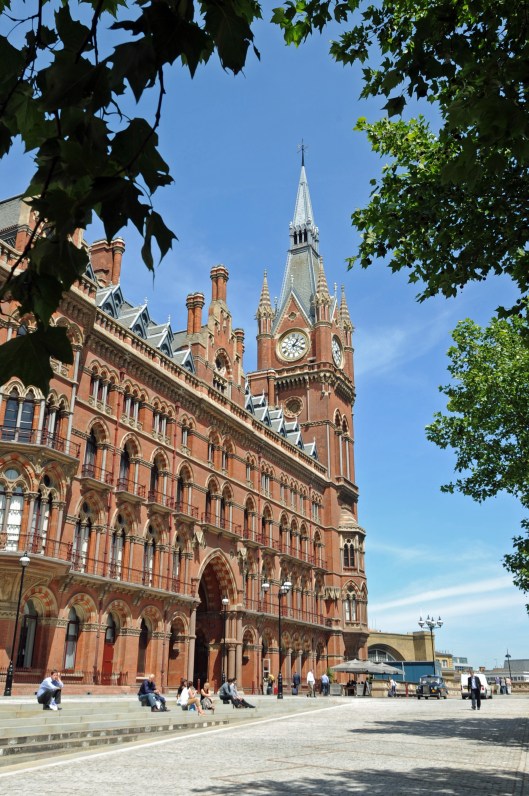
It’s sometimes easy to forget just how much of our railway heritage has been transformed since privatisation. First St Pancras, then Kings Cross next door. Now things have moved on up the road to Euston, which is to be completely rebuilt as the London terminus of High Speed 2. I look forward to documenting that fantastic project too…
I’ve a small favour to ask…
If you enjoy reading this or any of the other blogs I’ve written, please click on an advert or two. You don’t have to buy anything you don’t want to of course – although if you did find something that tickled your fancy that would be fab! – but the revenue from them helps me to cover some of the cost of maintaining this site (which isn’t cheap and comes out of my own pocket). Remember, 99% of the pictures used in my blogs can be purchased as prints from my other website – https://paulbigland.zenfolio.com/
Or – you can now buy me a coffee! https://ko-fi.com/paulbigland68312

Sorry Paul I have to disagree.
The article is very good and I have photos like you.
I personally hate the new St Pancras it’s all glass, metal and concrete with little character. The ticket office with it’s lovely wood panelling is now a overpriced bar (Can you imagine the old TO staff being asked for a return to Nottingham and a G&T LOL).
Externally it’s still a lovely station and a magnificent sight but inside it’s nothing than a bland shopping mall. The shops are very overpriced and are the Knightsbridge style. The roof look cleaner but apart from that it’s .. well soulless. Sadly they did the same to Kings Cross with the new concourse. It seems that the pride of the Victorian designers and builders has been replaced by cold concrete and metal carbuncles (Thanks Prince Charles for the phrase).
Don’t get me started on platforms A & B the Thameslink concrete coffins. Cold all year round.
Ahh but it’s progress …
Wouldn’t it be nice of the new Euston has been designed to be a tribute to the Victorian Builders … but I guess we don’t have skilled builders anymore 😦
I really wanted to like the new refurb; I love when old buildings are genuinely restored, it seems a lot of work has gone into this & everyone else likes it – yet I didn’t. The above reply has helped clarify why-!
I was fond of St Pancras from 80s/90s jaunts down to the capital. I’ve searched online for ‘before’ photos’ as it helps make my fuzzy memories more real. Ok, the station needed a ‘good fettle’, some TLC /cash, but it had an evocative charm & romance which the stark re-boot has lost.
I dislike the ‘kissing’ statue, & J.Betjamins great but what of Jane Fawcett & others who battled as prominently alongside him?
I never liked ‘malls’ so it isn’t for me, but I am glad St Pancras is alive & thriving, it needs posher richer customers to survive. The building exterior is very beautiful, & The Hotel also looks lovely, top quality.
One thing they got right is the Dent clock; the original was accidentally smashed c1978, then lovingly pieced togther by railwayman Roland Hoggard, & decades later used as a template for Dent to create an exact replica, reinstated where it belongs on the station wall; perfect 🙂
Great photos as ever Paul, showing the transformation of St. Pancras over the years.
Although you didn’t explicitly say so, the post gives the impression that this transformation is down to privatisation. However, the only reason St. Pancras has been transformed is because the government decided to inject large amounts of public funding into it (that’s the simple version – the history of HS1 funding is complex to put it mildly as I’m sure you’re aware).
The same goes for pretty much all the investment we’ve seen in railways since privatisation – the only notable exceptions I can recall are the various Chiltern Evergreen projects and Heathrow Express.
The lesson for me is that the railways need continued investment by the government. ‘Privatisation’ is a bit of a red herring.
The third photo is a reminder that MML was, in my view, one of the big successes of privatisation. The train service to stations between Bedford and Leicester used to be patchy and was much improved with the 170s. That said, I fear the service is starting to worsen again now and am dreading 20th May…